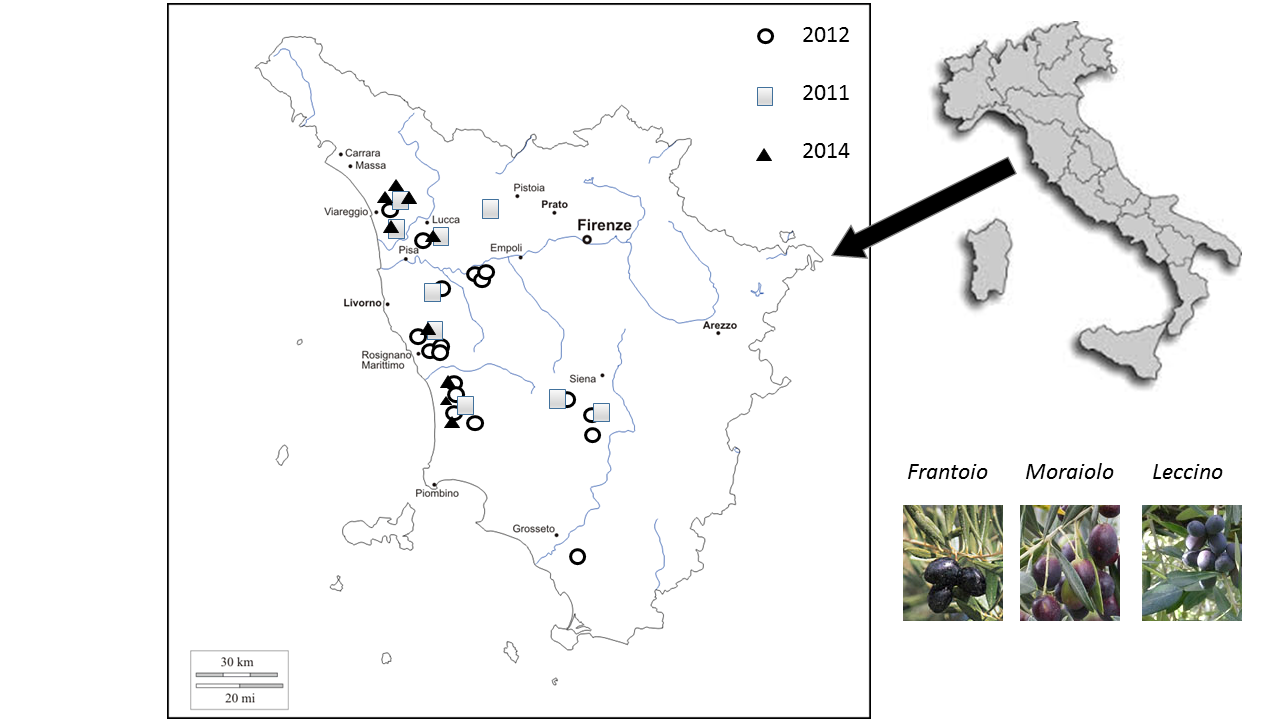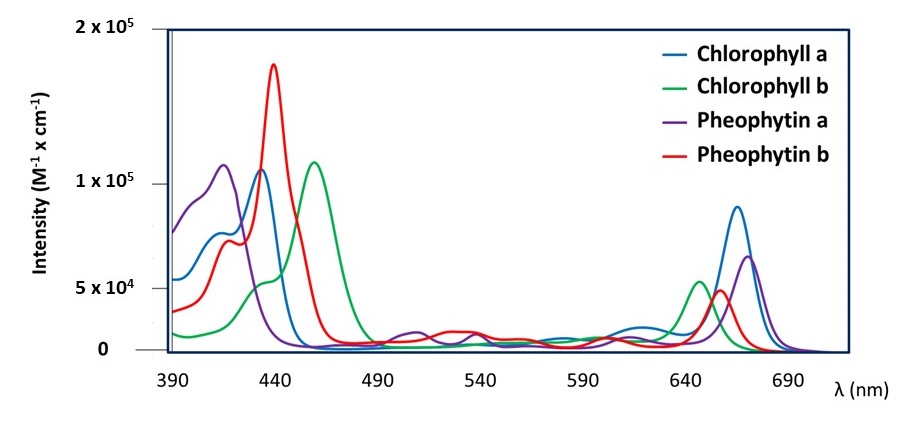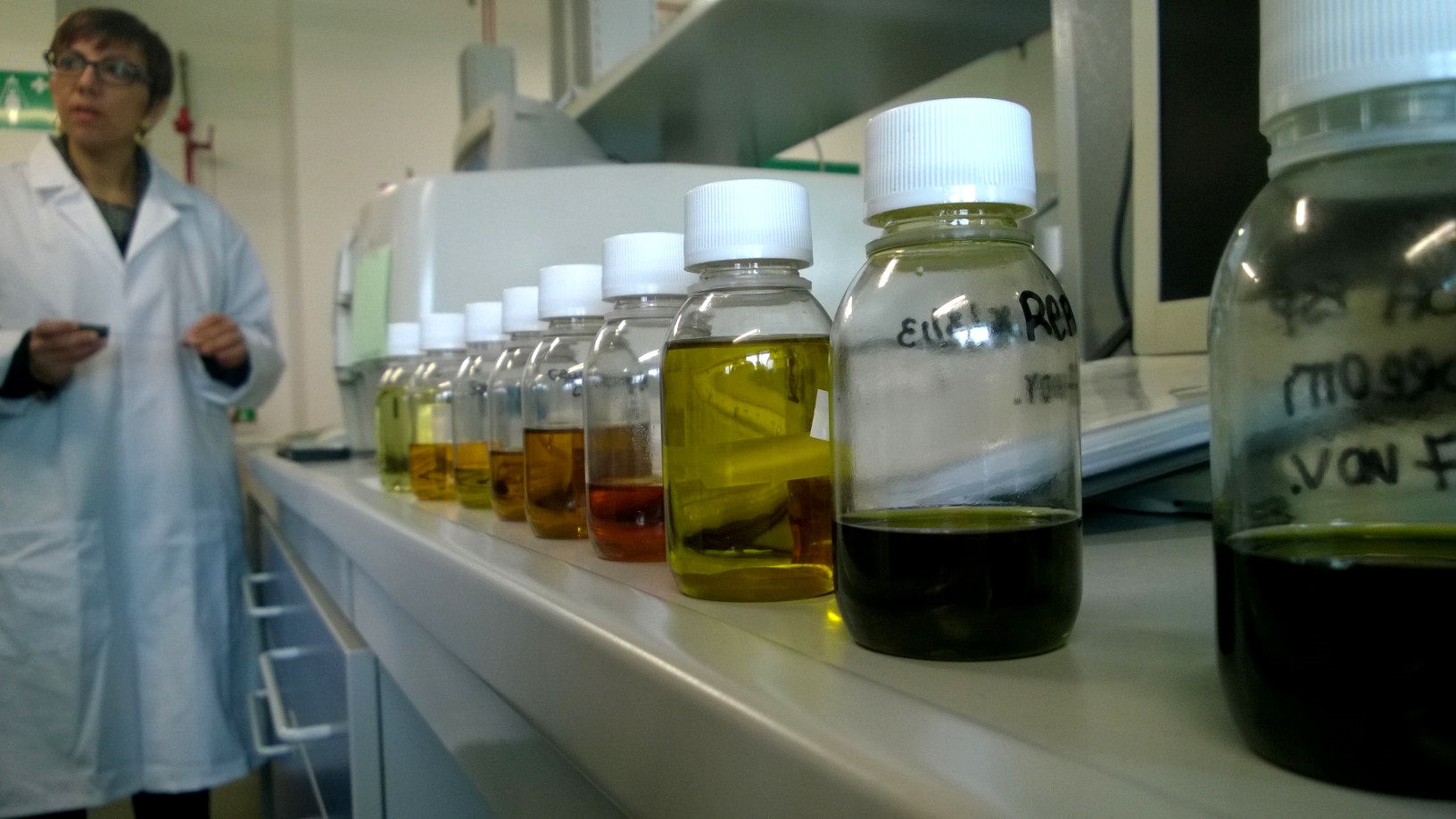
RESEARCH TOPICS AND RESOURCES
In our research group, we have developed several spectroscopic methods to characterize extra-virgin olive oils and to identify eventual frauds. Our first scientific contribution concerns the quantification of four main pigments in extra-virgin olive oil samples on the market (with a variable shelf life, after about 2-3 months from their production).
The original scientific paper is:
1) "Extraction of Pigment Information from Near-UV Vis Absorption Spectra of Extra Virgin Olive Oils", Valentina Domenici, Donatella Ancora, Mario Cifelli, Andrea Serani, Carlo Alberto Veracini & Maurizio Zandomeneghi, J. Agric. Food Chem. 2014, 62 (38) 9317–9325. Link to the paper.
This method is based on a spectral deconvolution of the UV-visible spectrum of an olive oil recorded in the bulk, without any chemical treatment, in terms of four pigments: b-carotene, lutein, pheophytin a and pheophytin b. This spectroscopic method has been tested with several hundreds of extra-virgin olive oils and it has been validated by a direct comparison with a more standard analytical technique, namely HPLC-DAD.
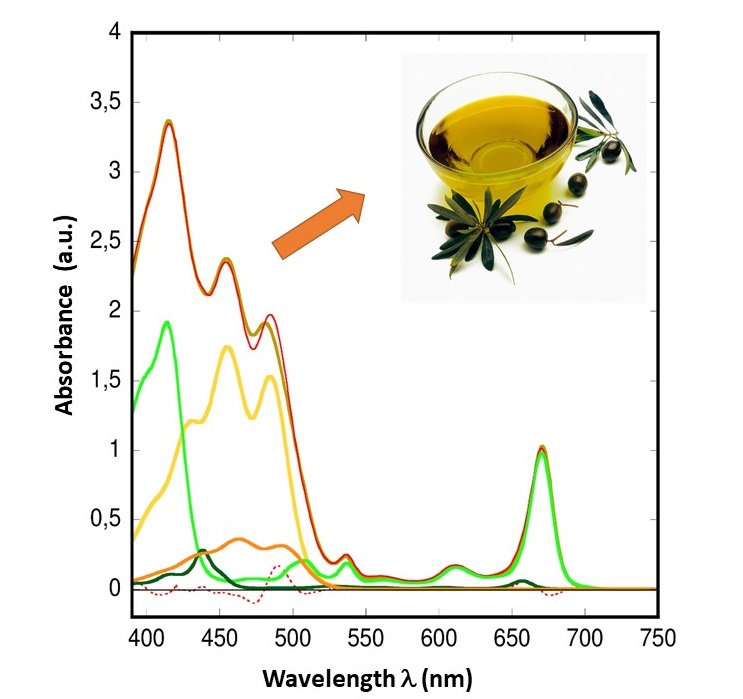
UV-visible spectrum of an extra-virgin olive oil analyzed in terms of main pigments.
Cited from ref. 1.
The results of these research studies are reported here:
2) "Pigments in Extra‐Virgin Olive Oil: Authenticity and Quality", Cristina Lazzerini, Mario Cifelli, Valentina Domenici, In "Products from Olive Trees", D. Boskou & M. Clodoveo Editors, 2016, INTECHOPEN Publisher, Chapter 6; ISBN: 978-953-51-2725-3. Link to the paper.
3) "Pigments in extra virgin olive oils produced in different mediterranean countries in 2014: Near UV-vis spectroscopy versus HPLC-DAD", Cristina Lazzerini, Mario Cifelli, Valentina Domenici, LWT - Food Science & technology, 2017, 84, 586-594. Link to the paper.
4) "Pigments in Extra-Virgin Olive Oils Produced in Tuscany (Italy) in Different Years", Valentina Domenici, Cristina Lazzerini, FOODS. 2017, 6 (4) 25. Link to the paper.
5) "Determination of Pigments in Virgin and Extra-Virgin Olive Oils: A Comparison between Two Near UV-Vis Spectroscopic Techniques", Eleonora Borello, Valentina Domenici, FOODS. 2019, 8 (1) 18. Link to the paper.
Olive oils from different monocultivar olives (Frantoio, Moraiolo & Leccino) produced in Tuscany.
Cited from ref. 4.
The research performed on the identification and quantification of main pigments in extra-virgin olive oils resulted in several dissemination contributions, mainly in Italian, and it was a stimulus for further developments of the method, with inclusion of additional pigments and to the study of fresh olive oils.
Recent implementation of the method:
Recently, the original deconvolution method has been implemented in order to include two additional pigments: chlorophyll a and chlorophyll b (see the molar extinction coefficients of the chlorophylls' derivatives used in the model below). The possibility to extract information about the chlorophyll a and chlorophyll b directly from the UV-vis absorption spectrum of olive oil is very important since it allows us to analyze freshly pressed olive oils, too.
Molar extinction coefficients (epsilon) of four main chlorophylls' derivatives present in olive oils: pheophytin a and pheophytin b, chlorophyll a and chlorophyll b. These coefficients were determined experimentally for single pigments diluted in triolein, as oil matrix. Cited from ref. 5b.
A complete and comprehensive study of freshly pressed olive oils and their pigments' content is reported here:
5b) "Study of the Evolution of Pigments from Freshly Pressed to ‘On-the-Shelf’ Extra-Virgin Olive Oils by Means of Near-UV Visible Spectroscopy", Eleonora Borello, Daniele Roncuci, Valentina Domenici, Foods. 2021, 10 (8) 1891. Link to the paper.
Additional research studies about extra-virgin olive oils:
6) "Near UV-Vis and NMR Spectroscopic Methods for Rapid Screening of Antioxidant Molecules in Extra-Virgin Olive Oil", G. Vicario, A. Francini, V. Domenici, M. Cifelli & L. Sebastiani. Antioxidants, 2020, 9 (12), 1245; doi: 10.3390/antiox9121245. Link.
7) "Effects of Extra Virgin Olive Oil and Apples Enriched-Dark Chocolate on Endothelial Progenitor Cells in Patients with Cardiovascular Risk Factors: A Randomized Cross-Over Trial". F. Felice, A. Francini, V. Domenici, M. Cifelli, E. Belardinelli, C. Cantini, R. Di Stefano & L. Sebastiani. Antioxidants, 2019, 8 (4), 88; doi: 10.3390/antiox8040088. Link.
8) "Analysis of Extra Virgin Olive Oils from Two Italian Regions by Means of Proton Nuclear Magnetic Resonance Relaxation and Relaxometry Measurements". Anton Gradišek, Mario Cifelli, Donatella Ancora, Ana Sepe, Boštjan Zalar, Tomaž Apih & Valentina Domenici. Journal of Agricultural Food Chemistry, 2021, 69, 12073-12080; doi: 10.1021/acs.jafc.1c00622. Link.
9) "Sensitivity of Proton NMR Relaxation and Proton NMR Diffusion Measurements to Olive Oil Adulterations with Vegetable Oils". Donatella, Ancora, Jerneja Milavec, Anton Gradišek, Mario Cifelli, Ana Sepe, Boštjan Zalar, Tomaž Apih & Valentina Domenici. Journal of Agricultural Food Chemistry, 2021, 69, 12081-12088; doi:10.1021/acs.jafc.1c00914. Link.
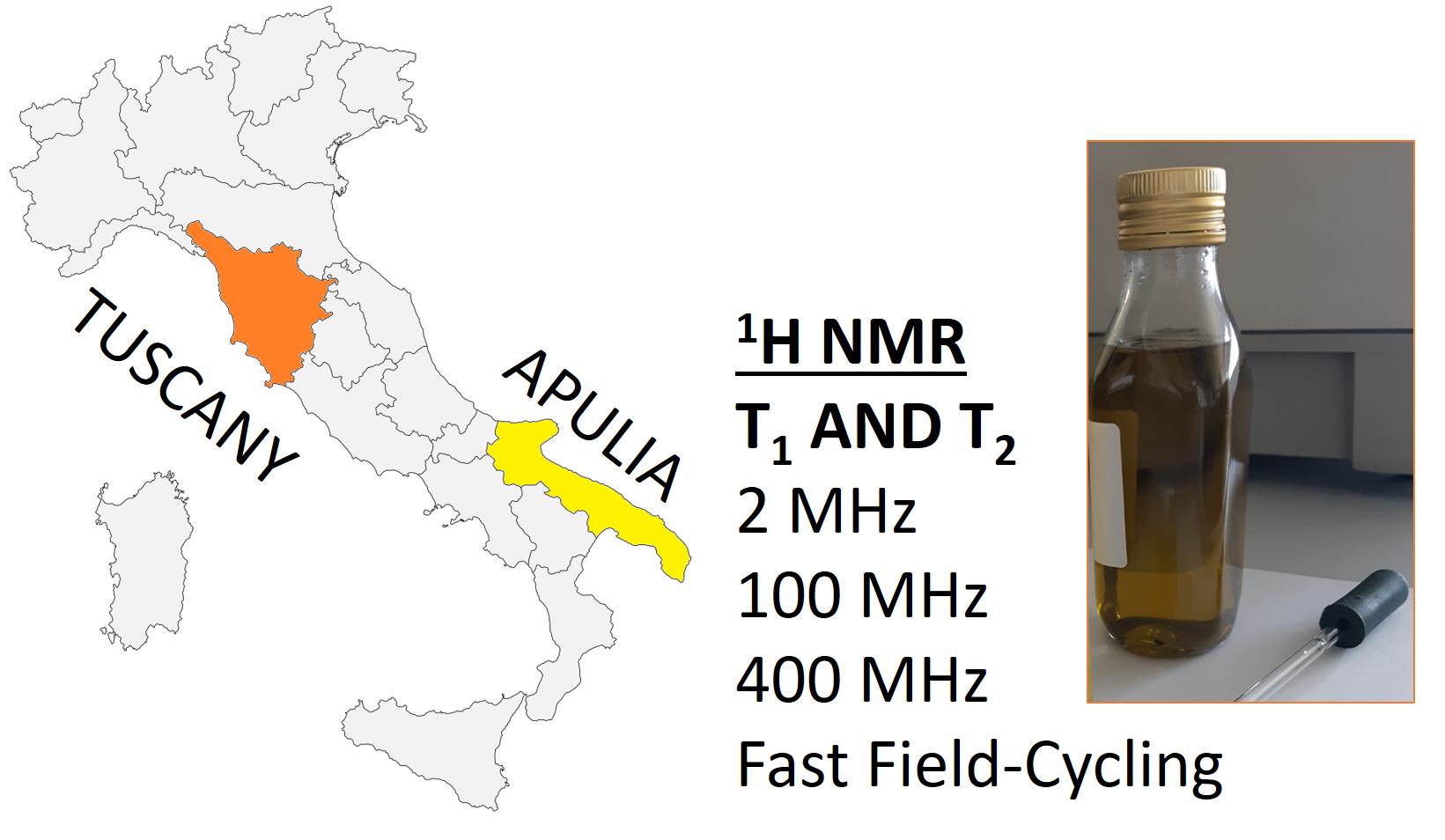
Olive oils from Apulia and Tuscany studied by means of Nuclear Magnetic Resonance Relaxation and FFC Relaxometry.
Cited from ref. 8.
Some resources and news (in Italian) about our spectroscopic method:
a) "Determinazione dei pigmenti e loro legame con parametri di qualità e autenticità dell’olio di oliva extravergine", V. Domenici, C. Lazzerini & M. Cifelli, In "Quaderni dei Georgofili". L’Olivo e il suo olio, una storia da proteggere per poterla tramandare. Link.
b) "Nuovo metodo di anticontraffazione dell'olio di oliva". Rassegna stampa di UNIPI.
c) "La scienza dell'olio". V. Domenici. Articolo su Scienzainrete.
d) "Metodo di analisi dell'olio". Link alla trasmissione di TG LEONARDO, 2015.
e) "Nuovo metodo di analisi dell'olio di oliva". Link all'articolo su La Repubblica, 2014.
f) "Ftalati, alchil esteri e panel test. Lo sguardo dell'American Oil Chemists Society sull'olio di oliva". V. Domenici, Articolo divulgativo su "Teatro Naturale".
Digital tools and didactic resources:
- A digital tool for the deconvolution of olive oil spectra in terms of pigments is now available. This digital tool, called "EVOODec", was produced in collaboration with Sandro Jurinovich, teacher at the technical high school 'ITS CATTANEO' in San Miniato.. The software is useful for teachers and students both at high school and undergraduate levels. The link to download the software is: https://github.com/sandroj87/EVOODec/releases. 
Logo of the software EVOODec.
Examples of activities and educational aspects of the analysis of olive oils by means of this application are reported in '‘Digital Tool for the Analysis of UV–Vis Spectra of Olive Oils and Educational Activities with High School and Undergraduate Students', Journal of Chemical Education, 2022, vol. 99, pp. 787-798. (https://doi.org/10.1021/acs.jchemed.1c01015)
IN ITALIANO:
Alcuni video introduttivi, pensati sia per studenti delle scuole secondarie di II grado sia per un pubblico di non addetti ai lavori, si trovano sul canale: "Brevi lezioni di chimica per tutti":
- Introduzione al fenomeno dell'assorbimento della luce: link.
- Pigmenti in un olio di oliva: link.
Ecco una serie di brevi presentazioni introduttive (file in pdf) sulla chimica dell'olio di oliva e sul metodo della determinazione quantitativa dei pigmenti presenti nell'olio di oliva:
- Presentazione della Chimica dell'Olio di Oliva - prima parte;
- Presentazione della Chimica dell'Olio di Oliva - seconda parte;
- Presentazione del metodo di analisi dei pigmenti mediante Spettroscopia UV-visibile.
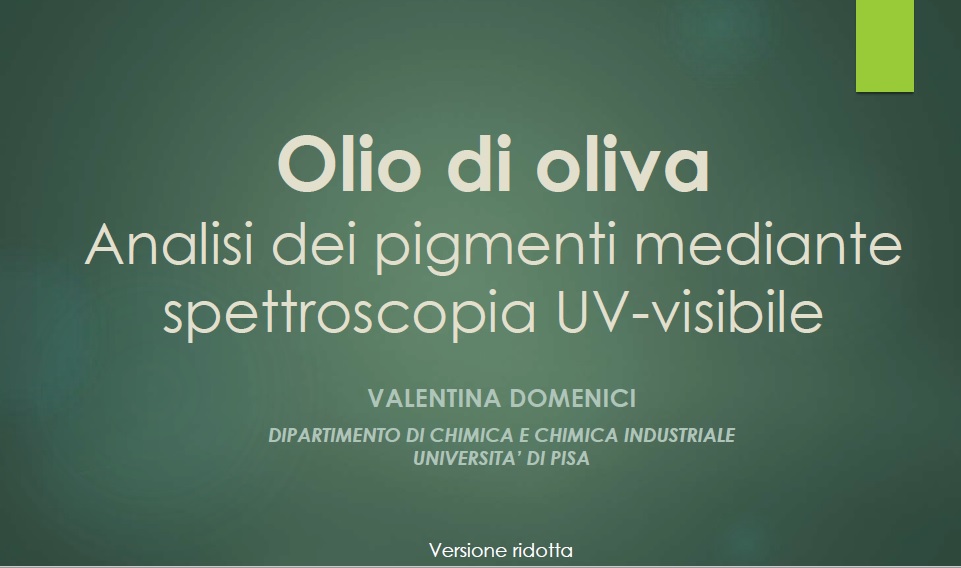
Degree thesis and Ph.D. projects focused on the study of extra-virgin olive oils by means of spectroscopic methods:
Donatella Ancora, "UV-vis and 1H-NMR spectroscopic methods applied to the study of extra-vergin olive oil produced in Tuscany and Apulia", 2014.
Francesco Buti, "Implementazione di un nuovo metodo per la determinazione di pigmenti in oli di origine vegetale", 2016.
Cristina Lazzerini, "Applicazione di un metodo spettroscopico innovativo per la determinazione di pigmenti in oli di oliva extravergine e confronto con un metodo cromatografico", 2016.
Daniele Roncucci, "Implementazione di metodo di spettroscopia nel vicino ultravioletto-visibile per lo studio di campioni di olio di oliva appena franto", 2017.
Eleonora Borello, "Quantificazione dei pigmenti principali in oli di oliva freschi e invecchiati, mediante modelli di analis di spettri di assorbimento nel vicino ultra-violetto-visibile e studio cinetico", 2018.
Giulia Vicario, "Near-UV-vis and NMR spectroscopic analysis of Tuscan extra-virgin olive oils", 2019 (Biosafety and Food Quality, Food, Agriculture and Environment Sciences).
Michela Massa, "Studio dell'effetto dall'azoto durante varie fasi di conservazione sulle proprietà chimiche e chimico-fisiche dell'olio di oliva" (in progress).
Giulia Vicario, Ph.D. "From olive fruit to olive oil: relation between olive abiotic stress response as well as agricultural practices and quality of fruit and oil", 2023 (Istituto Scienze della Vita, Scuola Superiore Sant'Anna).
Greta Cogno, "Quantificazione di oleacina e oleocantale nell'olio di oliva extravergine tal quale mediante 1H NMR", 2022.
Cinzia Nencini, "Studio della composizione chimica di oli extravergine di oliva mediante tecniche spettroscopiche complementari", 2025.
Luigi Caputo, "Studio mediante 1H NMR dell'evoluzione nel tempo dei secoiridoidi e dei loro derivati in campioni di olio extravergine di oliva sottoposti a diversi trattamenti", 2025.
Francesca Loni, "Studio delle adulterazioni di oli extravergine di oliva mediante spectroscopia FT-IR", in corso.
Elisa Rossi, "Studio dell'effetto della temperatura su oli extravergine di oliva mediante spettroscopia di fluorescenza", in corso.



